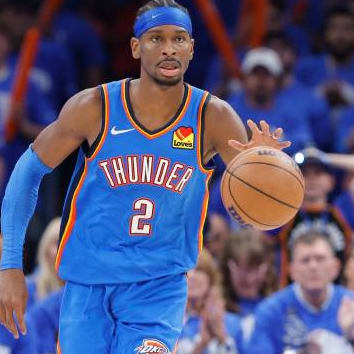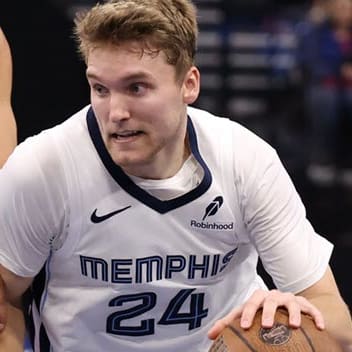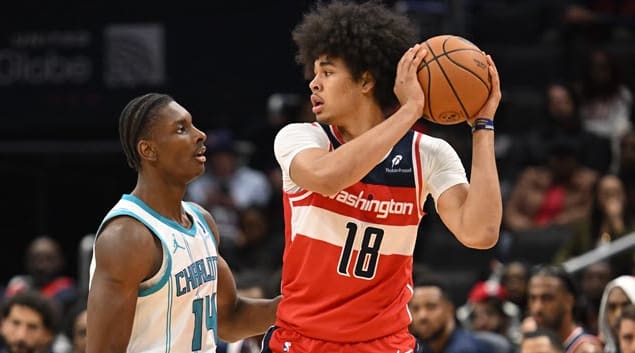When the playoffs take over the spotlight, standard contests give way to Single-Game contests.
In the early going, sites will often combine two day's worth of games to make a Classic format work, but the number of single-game formats (or Showdowns) will increase throughout the playoffs until it's your only option. There's a wealth of information out there about how to construct a winning DFS lineup, but Showdown contests are a completely different animal.
This article will give some insight into the structure of both DraftKings and FanDuel single-game contests and provide some winning strategies for each site.
DRAFTKINGS SHOWDOWNS
DraftKings showdowns have six available slots for players, and there are no positional requirements for the slots, which are referred to as UTIL (Utility) spots in the Classic format. The only differential is the CPTN (Captain) spot. While the UTIL positions will provide 1x of their production, the player in the CPTN slot receives 1.5x of their output.
For example, if you select Anthony Davis for the CPTN spot and he scores 50 points, he'll receive 75 points in the contest. The added wrinkle is that UTIL and CPTN salaries are different. Each player on the slate will have their standard salary, and if you select them as a CPTN, their salary will move to 1.5x their original price.
FANDUEL SINGLE-CAME CONTESTS
FanDuel allows only five players in its single-game contests, and while there is no salary multiplier, there are three multiplier spots. MVP (2x), Star (1.5x) and Pro (1.2) are combined with two utility spots to make up the single-game structure. While FanDuel's approach is more straightforward due to the static salaries, the basic approach is the same.
Before we delve into the specifics of each format, we should cover a few topics that apply to both sites. They are core principles to consider when constructing single-game lineups.
STACKING
If you think about the game flow of an NFL game, stacking makes a lot of sense. Since players' totals are often dependent on another player's success (a QB to a WR, for example), it's often a winning strategy to stack a QB with two receivers in a pass-heavy shootout.
For the NBA, it's an ill-advised route to take. With the exception of a point-to-assist advantage or a center grabbing rebounds against a poor-shooting team (tenuous edges at best), there's minimal incentive to load up on one team in a single-game showdown. In fact, the majority of winning lineups consist of three players from each team.
Basketball performance, unlike football, is based on a single player's actions. If a player like Russell Westbrook has the ball in his hands most of the time, it ultimately leaves fewer opportunities for his teammates. Since most winning lineups have a 3:3 or a 4:2 ratio, we will have to pick some players alongside a guy like Westbrook, which leads us to how each lineup should be correlated.
CORRELATION
Explaining correlation is best done by providing examples of what is a good correlation versus a bad correlation. Let's use the Trail Blazers as an example.
Pairing Damian Lillard or CJ McCollum with Jusuf Nurkic is an excellent example of a positive correlation. The two players are not in a position to siphon stats for the other, and sometimes they'll both benefit with an assist-to-point combination.
Pairing Lillard and McCollum is an example of a negative correlation. Even if you suspect that both players will have an excellent total, it will be exceedingly rare for both of them to have an equally good stat line. That's fine for a nine-game slate because McCollum has a lower salary, and if we can reap a good multiplier from his projected total, that might be a good way to go. That's not the case for a single-game showdown, however. We are limiting the total number of possessions to one game and one game only.
While we can find enough diversity to have some exposure to a McCollum and Lillard stack in a bulk-entry Classic scenario, all we have to do is look back at the Westbrook example to see why it's generally a bad strategy for showdowns. There's only one ball to go around -- when one player at a similar position has the ball, the other one doesn't.
Correlation also plays a part when you are fielding an even number of players for each team. If the game has a fast pace, pairing the opposing point guards is a fine idea, but using opposing centers isn't as advantageous. While guards and forwards can create their own shots in space, it's usually a one-on-one battle inside, and the player with the most rebounds is usually the better producer. While centers with identical totals aren't unheard of, it happens less frequently than one might think. If the pace is slow, pairing opposing forwards becomes a slightly more attractive option.
MAKE YOUR PROJECTIONS FIRST, THEN START AT THE BOTTOM
My personal belief is that you should always build your showdown and single-game affairs by starting at the bottom of the player pool and going up from there. Using this method, you can establish a decent group of low-cost players to mix and match as you move up the list to mid-range and elite options. This is especially true with DraftKings' salary multiplier, which we will get to later in the article.
If you've never made your own projections before, not to worry. You can use RotoWire's projections and modify them as you wish. If you're a brave soul and want to make your own projections, there is one good rule of thumb to follow. Assume that a player's fantasy point-per-minute total is generally going to fall between 0.5 and 1.5 FPPM.
Analyzing a player's average minutes total and assigning points to those minutes is a great baseline. You can then go down the rotation, making sure that the minutes total for each position ends up roughly the same. Doing this cuts down on assigning more minutes than are available. You can then tinker with your projections further, taking in recent trends, injury ramifications, and the usual concerns you tackle in Classic lineups.
A very popular way to quantify the best options on a given slate is the Value Multiplier. Finding this number is very simple.
Projected FP/ (Salary/1000) = VM
Let's say Russell Westbrook's salary is $12,200, and you project him to put up 65 FP. The equation would look like this:
65/12.2= ~5.3x
The higher someone's multiplier is, the more valuable they are in relation to their salary. 5x value is widely considered to be the Over/Under baseline for "good" value. Although the difference between, say, 5.2x and 4.8x is minuscule, numbers like 3.8x and 6.2x are very telling and tell a lot about what kind of production you might get from a given player relative to their salary. These numbers are purely based on projections, however. There are many ways to evaluate players, so whether you use point-per-dollar data, multipliers, or some other form of ranking players is immaterial. It's most important to have a reliable way of realizing a player's value relative to his salary. Ultimately, how you do it is a matter of personal preference.
When searching for value at the bottom, I'm looking for guys with low salaries who have a high-value multiplier. Since the WAS/BOS game is the only single-game contest currently available at the time of publication, we'll use it as an example. We will also use RotoWire's current projections, which could change as more data becomes available.
Robin Lopez (DK $2,200) = 6.4
Daniel Gafford (DK $3,200) = 5.7x
Davis Bertans (DK $5,200) = 4.8x
Since players who see limited minutes can often show slewed value totals, I picked the players with the best opportunity to realize their multiplier. With the average DK salary set at $8,333, we've found three budget utility guys that can bring the remaining average up significantly -- up to $13,133 per player, to be exact.
I can hear the protests: what about correlation? Aren't these players candidates to siphon each other's production? I wish we had a better example than the WAS/BOS game, but trust me when I tell you that correlation is USUALLY important. If anything, using this matchup will show us some instances where there are exceptions.
FINDING YOUR CORE
Why are Lopez, Gafford and Bertans good for this structure? Regardless of their negative correlation, they are the best candidates to realize their value, and at the same time, can get us to two core guys that will put up huge numbers.
The top candidates for me would be Jayson Tatum ($10,000) and Bradley Beal ($9,600). Both are top scoring options for their team, and their utility prices make it possible to put -- you guessed it -- Russell Westbrook (CPTN $19,200) in the CPTN spot on DraftKings. This is why this game is a horrible example. There is no way around picking Westbrook as the Captain unless you want to go ultra-contrarian. To flesh out the strategy for determining a Captain on DraftKings, we need to pivot to another example, using another team with imaginary salaries.
DRAFTKINGS CPTN ANALYSIS
Let's assume that at first glance, Giannis Antetokounmpo is our first obvious choice for Captain. His original price is $10,000, making his CPTN price $15,000. The 15k price creates a problem for the utility spots, however. Khris Middleton and Jrue Holiday cannot fit into the lineup without making a huge sacrifice with the available value options on either team.
Hypothetically, a move to Middleton as the CPTN could allow Holiday and Antetokounmpo into the UTIL spots, giving us the big three that we hoped for, but is it worth it? Assuming that the lower budget players remain the same, let's break down the FP-per-dollar amounts for the three players in question.
Antetokounmpo ($10,000 UTIL, $15,000 CPTN) - Projected 50 FP: $200 per FP
Middleton ($8,500 UTIL, $12,750 CPTN) - Projected 38 FP: $224 per FP
Holiday ($8,000 UTIL, $12,000) CPTN - Projected 35 FP: $228 per FP
Since the CPTN totals take into account the 1.5 point increase as well, the point-per-dollar numbers are identical for both salaries.
Let's look at the scenario where Giannis is the CPTN but has to sacrifice Middleton or Holiday as a result. First, let's calculate how much the salary differential is worth to us with Giannis in the top spot. At $200 per point, the extra $5000 equals 25 additional FP for Giannis, according to our projections. Assuming we can only keep Middleton in this scenario, we lose Holiday's total and are forced to pivot to Kendrick Nunn, who is projected for 26 FP. Our lineup suffers a loss of 9 FP by the switch, giving us a net gain of 16 FP.
Now let's look at Middleton as the Captain, who can allow us to have Holiday and Antetokounmpo in the lineup as UTIL players. At his salary and projection, the salary differential of $4,250 is worth an additional 18.9 points. We lose 6.1 FP due to the Captain switch, but by regaining Holiday's 35 points, we realize a gain of 9 FP over Nunn, giving us a net gain of 3.1 FP. We also have to factor in the improvement from Midleton to Giannis in the switch, which adds 12 points to the total for a net gain of 15.1 FP.
While these totals are imaginary and not intended as a guide to this specific matchup, the math tells us that using Giannis is slightly better, but it's very close. As you can imagine, slight tweaks in projections could make a huge difference. A variance of even five percent for any of the four players could totally change the math, but at the very least, it gives us a path to justify Middleton as the CPTN in some of our builds.
In summary, analyzing the point differential relative to the CPTN salary increase is the best way to decide who gets the 1.5x point boost. If you can get a better player and more production by sacrificing what a prospective Captain might give you with the increase, then swapping him for someone else might be the better way to go. Although a guy like Westbrook defies most of the math, other matchups can be much closer.
FANDUEL: THE SAME, BUT DIFFERENT
Although you are allowed an average of $12,000 per spot for the five-person roster, the salaries for the available players are very inflated and look more like the DraftKings CPTN salaries than their usual numbers. This element immediately limits our options from a cost perspective.
Using WAS/BOS as an example, we can still get two budget guys into the UTIL spots, but you wouldn't be able to get Westbrook, Tatum and Beal in without going even lower. This brings players with lower multipliers like Evan Fournier or Kemba Walker as subs in the top spots, and alternate budget picks like Aaron Nesmith or Tristan Thompson.
FanDuel is the better site to field multiple lineups because although the top three slots provide additional production, there are no salary restrictions for the multipliers, which allow for a wide variety of combinations. You can still use the formulas we utilized above to realize the overall worth of one player over another compared to their salary, but instead of providing a salary differential, you are strictly looking at differences in production and finding the right combination of players to yield the most value.
In that respect, it's very similar to a Classic DFS contest. Many players prefer using the multipliers to create a similar point total for three players and allowing the elites to perform with 1x value, but players like Westbrook, Kevin Durant and Nikola Jokic are just too productive to avoid a 2x boost. The biggest mistake in this format is undervaluing the 2x spot and overvaluing the 1.2x spot.
If Player A has a projection of 50 FP, it becomes 100 at the top spot but only worth 60 in the bottom multiplier. When you look at it that way, you can see how pivotal the 2x slot is. By and large, you want your top producer to get in that position and go from there. If that player is less clear, you can experiment with players in various multiplier positions while still accounting for good value in the UTIIL spots. Teams like Miami, Boston and Memphis are squads where you'll want to do more mixing and matching, while teams like Philadelphia, Portland, Washington and Golden State have obvious lock candidates for the 2x spot.
Although I've painted some very broad strokes in this article, I hope it provides a solid foundation as Single-Game DFS becomes more and more prevalent during the playoffs.






































